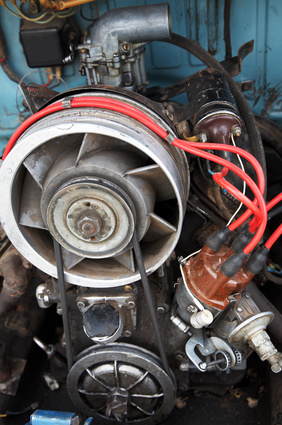
The carburetor acts like a mixing bowl for air and fuel, which it sends down into the intake manifold for combustion in the cylinders. The amount of air that passes through the carburetor throat must be precisely measured and delivered. Sometimes air can enter through a broken seal, hose or gasket and create a vacuum leak. A vehicle owner can spot and repair vacuum leaks in the carburetor if he knows what to look for.
Several vacuum hoses, or small lines, can be attached to the carburetor, usually at its base or throttle bottle. One source for a vacuum hose leak may be at the diaphragm positioning valve, which has a small rubber line connected to it. The diaphragm position valve looks like a small plastic case and sits near the throttle body. The valve tip, or nipple, can loosen and cause the carburetor to leak. Gently tapping the nipple end with a small hammer can re-seat it. The vacuum hose may crack or split too, which requires replacement. All vacuum hoses must have tight fittings, whether connected to the positive crankcase ventilation (PCV) valve that sits in the valve cover, exhaust gas recirculation (EGR) system that ports into the intake manifold, or any other vacuum sensor port. All lines and hoses should be pliable and not dried out.
The throttle shaft holds the small circular plate in the carburetor that allows the fuel to enter into the intake manifold. From constant use of the throttle shaft, the interior sleeve can wear out and cause misalignment in the plate. This will cause excessive air bypass, creating a vacuum leak. The repair procedure involves replacing the inner sleeve and the throttle shaft.
The throttle body gasket, also called the carburetor base gasket, is the most common source of a vacuum leak. The seal between the carburetor base and the intake manifold must be air tight. Sometimes this gasket deteriorates because of heat and age, or the throttle body base bolts loosen up. The repair involves retightening the bolts or replacing the gasket.
Carburetor spacers sit between the throttle bottle and the intake manifold, designed to heighten the carburetor off the manifold. Adaptors perform the same function, but both devices also block the conducted heat between the manifold and the carburetor so fuel does not boil in the carburetor bowl. Spacers and adaptor gaskets can wear, opening up a vacuum leak. They should be replaced if found in deteriorated condition. Keep in mind that any throttle body adaptor will have two gasket sides, so both should be checked for integrity.
The carburetor should be examined for any small rubber plugs that cover vacuum ports. These extra accessory ports are capped off because a component has been removed or the carburetor was purchased as an aftermarket edition. Any bare nipples should be replugged. The rubber caps must be replaced if they display loose fittings or cracks.
The idle speed and mixture screws, usually located near the base of the carburetor, have threads, seats and tiny gasket rings. An idle or mixture screw that has backed out of its seat, or has damaged threads, can cause a small vacuum leak. Repair involves replacing these small adjusting screws and their gasket rings, as well as cleaning the seats.